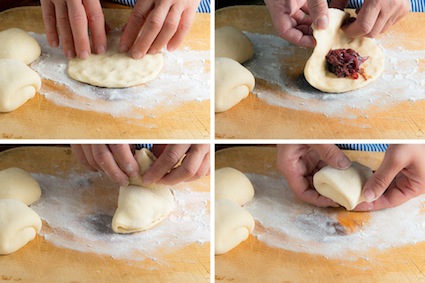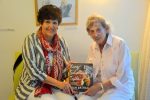Cookbook author Joan Nathan, left, with journalist Sybil Kaplan. (photo from Barry A. Kaplan)
Before I review King Solomon’s Table: A Culinary Exploration of Jewish Cooking around the World by Joan Nathan (Knopf, 2017), I have to admit, I am prejudiced. I have known Joan for around 40 years, and every cookbook she writes is great. When she was in Israel recently, she agreed to appear at my English-speaking chapter of Hadassah Israel for a fundraiser. The program included my interviewing her, and her remarks are at the end of this article, after the recipes.
In King Solomon’s Table, Joan traces, through recipes and stories, the journey of many of the dishes that Jews eat, the people she has met over the years and the places she has visited. Alice Waters, well-known chef, food activist, owner and founder of Chez Panisse Restaurant in Berkeley and cookbook author, writes in the foreword: “Joan has become the most important preservationist of Jewish food traditions, researching and honouring the rich heritage that has connected people for millennia.”

Joan’s introduction is an amazing history of the roots of Jewish food. This is followed by “The Pantry,” a discussion of spices and other items. Then there are the chapters and recipes. Every recipe has a story, and there are 171 recipes in 12 chapters. One can find recipes from Azerbaijan, Brazil, Bulgaria, Denmark, Ethiopia, France, Georgia, Germany, Hungary, India, Iraq, Israel, Italy, Kurdistan, Libya, Lithuania, Mexico, North Africa, Persia, Poland, Rhodes, Romania, Russia, Siberia, Sicily, Sri Lanka, Syria, Turkey, the United States, Uzbekistan and Yemen.
The variety is vast, from Hungarian Apple Pancakes to Sri Lankan Breakfast Buns, from French Buttery Olive Biscuits to Greek Eggplant Salad to Uzbek Noodle Soup. There are all sorts of breads, and recipes using couscous and different types of pasta. There are 15 vegetable recipes, 15 fish recipes, 10 recipes for poultry and 14 meat recipes. And, of course, there are recipes for sweets – 23 of them, including Sephardic Almond Brittle, Israeli Quince Babka and Brazilian Cashew Nut Strudel.
Scattered throughout the book are essays and, after the acknowledgments is a bibliography and index.
When Joan guest blogged for the Jewish Book Council, soon after the publication of the cookbook, she wrote: “One of the ideas that I have wrestled with throughout my career is the question of what is ‘Jewish food.’ Working on my latest cookbook, King Solomon’s Table: A Culinary Exploration of Jewish Cooking around the World, has at last answered that question for me.”
Here are a few of the recipes from this book.
SMOKY SHAKSHUKA
The name shakshuka comes from an Arabic and Hebrew word meaning “all mixed up.” It is said the dish was made in North Africa, when the women were busy with a lover and then made a quick meal for their husbands; it was born in the mid-16th century. This recipe makes eight servings.
4 red bell peppers
1 (1 pound) eggplant
2 tbsp olive oil
3 lamb, beef or chicken chorizo, sliced in rounds (optional)
5 chopped garlic cloves
12 chopped tomatoes or 28-ounce can chopped tomatoes
1 tbsp smoked Spanish paprika
2 tsp salt or to taste
1/4 tsp black pepper or to taste
1 tbsp sugar or to taste
1 bunch chopped cilantro
8 large eggs
crumbled Bulgarian feta cheese
1. Preheat the oven to 450°F and line a jelly roll pan with parchment paper. Cook the peppers and eggplant, pricking them first with a fork, turning occasionally with tongs until slightly soft and blackened, about 20 minutes.
2. Heat the oil in a pot over medium heat. Add peppers and fry about three minutes then add chorizo, if using, and garlic and cook six to seven minutes, stirring occasionally. Add tomatoes and simmer, uncovered, over medium-low heat for 30 minutes, stirring occasionally.
3. When the mixture is thickened, add the smoked paprika, salt, pepper, sugar, eggplant and all but three tablespoons of the cilantro. Stir to combine, Add seasonings to taste and add a little water if the mixture is too thick.
4. With the back of a spoon, make eight shallow wells in the shakshuka. Gently crack the eggs into the wells, cover the pot and poach over medium-low heat for five to 10 minutes until egg whites are set. Serve sprinkled with remaining cilantro and, if you like, Bulgarian feta cheese.
PICKLED HERRING SPREAD
(6-8 servings)
2 tbsp chopped red onion
1 tbsp almonds
1/2 Granny Smith or other tart apple, peeled and cored
1 large peeled hard-boiled egg
1 12-ounce jar marinated herring tidbits
1 tbsp fresh chopped dill
1. Pulse onion and almonds in food processor. Then add apple and egg to combine.
2. Pour off sauce and onions from marinated herring and add to food processor to chop. Place mixture in serving dish and sprinkle with dill to garnish.
LEEK AND MEAT PATTIES
The original 100-year-old recipe from Macedonia was a holiday staple for Balkan Jews, which Joan tampered with a bit. This recipe makes 12 patties.
1 1/4 cup olive oil
6-8 chopped leeks
2 1/4 tsp kosher salt
1/2 tsp black pepper
2 pounds chopped lamb, beef or boiled potatoes
3 large eggs
1 tsp cinnamon
1/2 tsp allspice
1/2 cup chopped parsley
1/2 cup matzah meal
1. Preheat oven to 425°F and rub a rimmed baking sheet with oil. Toss leeks with more oil, one teaspoon salt and pepper. Spread leeks in single layer and roast, tossing frequently until golden brown and crisp at edges, about 20 minutes. Cool.
2. Chop leeks and mix with meat or boiled potatoes, eggs, cinnamon, allspice, parsley, matzah meal and salt. Form into 12 patties. Heat a frying pan with a thin film of oil. Fry the patties until golden brown on each side, making sure they cook through. If using potatoes instead of meat, add a little Parmesan cheese for extra flavour.
***
An Interview with Joan Nathan in Jerusalem, June 15, 2017
SK: How did you decide to continue in food writing after you left Israel in the 1970s?
JN: We moved to the Boston area and I met with an editor at the Boston Globe. He asked me to write about food. I also had a scholarship to the Kennedy School at Harvard to do a master’s in public administration. I also met Dov Noy, z”l, the world’s renowned Jewish folklorist, who said, I’ll help you if you decide to write a cookbook, because he knew a lot about ethnic groups.
[At some point,] I told Julia Child’s editor I wanted to write a cookbook, but my father wanted me to go to Schocken Publishers.
[Schocken published The Jewish Holiday Kitchen in 1979, An American Folklife Cookbook in 1985, The Children’s Jewish Holiday Kitchen in 1988, The Jewish Holiday Baker in 1997 and Joan Nathan’s Jewish Holiday Cookbook in 2004. Knopf published Jewish Cooking in America in 1994, The Foods of Israel Today in 2001, The New American Cooking in 2005, and Quiches, Kugels and Couscous: My Search for Jewish Cooking in France in 2010.]
SK: How long does it take you to write a cookbook?
JN: King Solomon’s Table took six years. On a trip to India, I saw a sign, “Since the time of Solomon,” and got the idea, although the [part of the title] … about my journeys everywhere was my editor’s idea.
SK: How did you acquire the recipes?
JN: I sent out to all the “tribes.”
[Joan digressed here to say that the three essentials for Jewish food are the dietary laws; that Jews went out to look, for example, for spices; and how Jews’ food is influenced by the food of the country in which they’re living.]
SK: Who does the various elements of a cookbook?
JN: I have people help me in testing and I do my research. In the process of putting together a book, professional photographs are essential today. For King Solomon’s Table, I knew where I would go in the world…. I would plan trips for 10 days and, when I returned, I got the material typed quickly. The whole book comes together with the introduction. Each of my books is like a big term paper.
Sybil Kaplan is a journalist, lecturer, book reviewer and food writer in Jerusalem. She created and leads the weekly English-language Shuk Walks in Machane Yehuda, she has compiled and edited nine kosher cookbooks, and is the author of Witness to History: Ten Years as a Woman Journalist in Israel.

